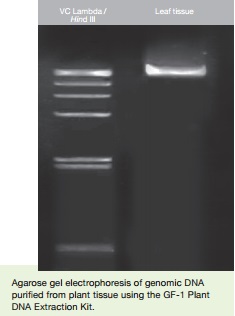Description
The GF-1 Plant DNA Extraction Kit is designed for rapid and efficient purification of genomic DNA from a wide variety of plant tissues. The purification is based on the usage of denaturing agents to provide lysis of tissue cells, denaturation of proteins and subsequently release of genomic DNA. Special buffers provided in the kit are optimized to enhance binding of DNA onto a specially-treated glass filter membrane for efficient recovery of highly pure genomic DNA.
Features
- Yields up to 20μg of DNA
- No organic-based extraction required
- Highly pure genomic DNA ready to use for routine molecular biology applications such as restriction enzyme digestion, PCR, Southern blotting and DNA fingerprinting.
Kit Components
- Buffer PL
- Buffer PB
- Wash Buffer (concentrate)
- Elution Buffer
- Proteinase K

Ordering Information
| Catalog No | Description | Pack Size |
| GF-PT-050 | GF-1 Plant DNA Extraction Kit | 50 preps |
| GF-PT-100 | GF-1 Plant DNA Extraction Kit | 100 preps |
Download
Manual
Download
MSDS
Stability Test Report
Publication
This Product Has Been Used In:
Poonsin, R. and Parinthawong, N. (2020). Investigation of rice blast resistant genes in Thai elite rice varieties (Oryza sativa L.) for improvement of broad-spectrum blast disease resistance variety, . International Journal of Agricultural Technology 2020 Vol. 16(1): 109-118.
Suksiri W & Parinthawong N (2020) Investigation of blast resistance genes in a broad-spectrum resistant indigenous rice, Yang Mawg variety, International Journal of Agricultural Technology, 16(1):155-162.
Vijitra Luang-In et al. (2020) Cytotoxicity of Selenium-Enriched Chinese Kale (Brassica oleracea var. alboglabra L.) Seedlings against Caco-2, MCF-7 and HepG2 Cancer Cells, Pharmacognosy Journal, 12(4):678-681.
Yuwa-Amonrpitak & Yeunyaw (2019) Comparative Study of Ethanol Production from Cassava Pulp by a Mixed Culture of Amylomyces rouxii with Zygosaccharomyces pseudorouxii and Zymomonas mobilis,. Biomedical & Pharmacology Journal, 12(1):199-210.
Fatima T, Srivastava A, Somashekar PV, Hanur VS (2018) Optimization of genomic DNA Extraction Routine from Rosewood (Dalbergia atifolia) and Ben Teak (Lagerstroemia lanceolata), International Journal of Genetics, 10(6):446-451.
Chow, Y.Y., Rhaman, S., Ting, A.S.Y. (2017) Understanding colonization and proliferation potential of endophytes and pathogen in planta via plating, polymerase chain reaction and ergosterol assay. Journal of Advanced Research. 1(1) pp.13-21
CRivera, M.P., Cardenas, L.B. (2017). Species Delineation of Kaempferia galanga L. and Kaempferia pulchra L. in the Phillipines using psbA-trnH and petA-psbL-psbJ, . Biomedical Research, Vol. 16, No. 2., 84-93 (2017).
Alabsi, A.M., et al. (2016) Cell Cycle Arrest and Apoptosis Induction via Modulation Mitochondrial Integrity by Bcl-2 Family Members and Caspace Dependence in Dracaena cinnabari-Treated H400 Human Oral Squamous Cell CarcinomaBioMed Research International.
Rawat, S., Joshi G., Annapurna, D., Arunkumar, A.N., Karaba, N.N. (2016). Standardization of DNA Extraction Method from Mature Dried Leaves and ISSR-PCR Conditions for Melia dubia Cav.— A Fast Growing Multipurpose Tree Species, American Journal of Plant Sciences Vol. 7, 437-445.
Rawat, S. et al. (2016) Standardization of DNA Extraction Method from Mature Dried Leaves and ISSR-PCR Conditions for Melia dubia Cav. – A Fast Growing Multipurpose Tree SpeciesAmerican Journal of Plant . Sciences, 7, p. 437-445.
Chen, S.H., Ting, A.S.Y. (2015) Biosorption and biodegradation potential of triphenylmethane dyes by newly discovered Penicillium simplicissimum isolated from indoor wastewater sample. International Biodeterioration & Biodegradation. 103. Pp.1-7
Chen, S.H., Ting, A.S.Y. (2015) Biodecolorization and biodegradation potential of recalcitrant triphenylmethane dyes by Coriolopsis sp. isolated from compost. Journal of Environmental Management 150. Pp.274-280.
Chow, Y.Y., Ting, A.S.Y. (2015) Endophytic l-asparaginase-producing fungi from plants associated with anticancer properties. Journal of Advanced Research. 6(6) pp.869-876.
Kraberger, S., Kumari, S.G., Hamed, A.A., Gronenborn, B., Thomas, J.E., Sharman, M., Harkins, G.W., Muhire, B.M., Martin, D.P., Varsani, A. (2015) Molecular diversity of Chickpea chlorotic dwarf virus in Sudan: High rates of intra-species recombination – a driving force in the emergence of new strains. Infection, Genetics and Evolution. 29. Pp.203-215.
Goh, K.M., et al. (2014) Infection Potential of Vegetative Incompatible Ganoderma boninense Isolates with Known Ligninolytic Enzyme Production. African Journal of Biotechnology . ProQuest. 13(9), p. 1056-1066
Karaaslan C et. al., (2014) Comparison of Six Commercial DNA Extraction Kits for DNA Extraction from Wheat, Journal of Biology and Chemistry 2014, 42 (3),395-400
Lee, H.H., et al (2014) Genotypic, Grain Morphological and Locality Variation in Rice Phytate Content and Phytase Activity. Emirates Journal of Food and Agriculture ProQuest. 26(10), p. 844-852.
Lee, J.M., Tan, W.S., Ting, A.S.Y. (2014). Revealing the antimicrobial and enzymatic potentials of culturable fungal endophytes from tropical pitcher plants (Nepenthes spp.) Mycosphere, Vol. 5, No. 2, 364-377 (2014).
Wong, L.M., Silvaraj, S., & Phoon, L.Q. (2014) An optimised High-salt CTAB Protocol for Both DNA and RNA Isolation from Succulent Stems of Hylocereus sp. Journal of Medical and Bioengineering, 3(4): 236 – 240.
Lee, J.J., Ahmad, S., Roslan, H.A. (2013). Transformation of Morinda citrifolia Via Simple Mature Seed Imbibition Method, Pakistan Journal of Biological Sciences, 16, 1913-1921.
Sangdee, A., Sangdee, K. (2013). Isolation, identification, culture and production of adenosine and cordycepin from cicada larva infected with entomopathogenic fungi in Thailand, African Journal of Microbiology Research,Vol. 7, No. 2, 137-146 (2013).
Hipol, R.M. (2012)Molecular Identification and Phylogenetic Affinity of Two Growth Promoting Fungal Endophytes of Sweet Potato (Ipomea batatas (L.) Lam.) from Baguio City, Philippines. Electric Journal of Biology, 8(3): 57-61.
Charoenporn, C., et al (2010) Evaluation of Bio-agent Formulations to Control Fusarium Wilt of Tomato. African Journal of BiotechnologyProQuest. 9(36), p. 5836-5844.
Wong SC et. al. (2009) Analysis of Sarawak Bario Rice Diversity Using Microsatellite Markers, American Journal of Agricultural and Biological Sciences 4 (4): 298-304, 2009




